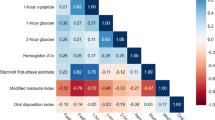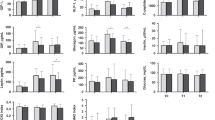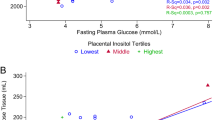Abstract
Background/Objectives:
Fetal energy demands are met from the oxidation of maternally supplied glucose and amino acids. During the fasted state, the glucose supply is thought to be met by gluconeogenesis. Underweight women with low body mass index (BMI) might be unable to adequately supply amino acids to satisfy the demands of gluconeogenesis.
Subjects/Methods:
Glucose kinetics were measured during the first and second trimesters of pregnancy in 10 low-BMI and 10 normal-BMI pregnant women at the 12th hour of an overnight fast using a primed 6 h U-13C glucose infusion and was correlated to maternal dietary and anthropometric variables and birth weight.
Results:
Low-BMI mothers consumed more energy, carbohydrates and protein, had faster glucose production (Ra) and oxidation rates in the first trimester. In the same trimester, dietary energy and carbohydrate correlated with glucose production, glycogenolysis and glucose oxidation in all women. Both groups had similar rates of gluconeogenesis in the first and second trimesters. Glucose Ra in the second trimester was weakly correlated with the birth weight (r=0.4, P=0.07).
Conclusions:
Maternal energy and carbohydrate intakes, not BMI, appear to influence glucose Ra and oxidation in early and mid pregnancy.
This is a preview of subscription content, access via your institution
Access options
Subscribe to this journal
Receive 12 print issues and online access
$259.00 per year
only $21.58 per issue
Buy this article
- Purchase on Springer Link
- Instant access to full article PDF
Prices may be subject to local taxes which are calculated during checkout

Similar content being viewed by others
References
ACC/SCN (2000). Low birthweight. In: Pojda J, Kelley L (eds). A Report based on the International Low Birth Weight Symposium and Workshop Held on 14–17 June 1999, Dhaka, Bangladesh. Nutrition Policy Paper 18. Administrative Committee on Coordination/Subcommittee on Nutrition: Geneva.
Assel B, Rossi K, Kalhan S (1993). Glucose metabolism during fasting through human pregnancy: comparison of tracer method with respiratory calorimetry. Am J Physiol 265, E351–E356.
Bang AT, Reddy HM, Bang RA, Deshmukh MD (2005). Why do neonates die in rural Gadchiroli, India? (Part II): estimating population attributable risks and contribution of multiple morbidities for identifying a strategy to prevent deaths. J Perinatol 25, S35–S43.
Balasubramanyam A, McKay S, Nadkarni P, Rajan AS, Garza A, Pavlik V et al. (1999). Ethnicity affects the postprandial regulation of glycogenolysis. Am J Physiol 277, E905–E914.
Butte N (2000). Carbohydrate and lipid metabolism in pregnancy: normal compared with gestational diabetes mellitus. Am J Clin Nutr 71, 1256S–1261S.
Chhabra P, Sharma AK, Grover VL, Aggarwal OP (2004). Prevalence of low birth weight and its determinants in an urban resettlement area of Delhi. Asia Pac J Public Health 16, 95–98.
Catalano PM, Huston L, Amini SB, Kalhan SC (1999). Longitudinal changes in glucose metabolism during pregnancy in obese women with normal glucose tolerance and gestational diabetes mellitus. Am J Obstet Gynecol 80, 903–916.
Catalano PM, Tyzbir ED, Wolfe RR, Calles J, Roman NM, Amini SB et al. (1993). Carbohydrate metabolism during pregnancy in control subjects and women with gestational diabetes. Am J Physiol 264, E60–E67.
Ceesay SM, Prentice AM, Cole TJ, Foord F, Weaver LT, Poskitt EM et al. (1997). Effects on birth weight and perinatal mortality of maternal dietary supplements in rural gambia: 5 year randomised controlled trial. Br Med J 315, 786–790.
de Onis M, Blossner M, Villar J (1998). Levels and patterns of intrauterine growth retardation in developing countries. Eur J Clin Nutr 52, S5–S15.
Duggleby SL, Jackson AA (2001). Relationship of maternal protein turnover and lean body mass during pregnancy and birth length. Clin Sci (London) 101, 65–72.
Duggleby SL, Jackson AA (2002). Protein, amino acid and nitrogen metabolism during pregnancy: how might the mother meet the needs of her fetus? Curr Opin Clin Nutr Metab Care 5, 503–509.
Durnin JVGA, Wormesely J (1974). Estimates of total body fat from skinfold thickness: measurements on 481 men and women aged from 16 to 72 years. Br J Nutr 32, 77–79.
Farmer G, Russell G, Hamilton-Nicol DR, Hamilton-Nicol DR, Ogenbede HO, Ross IS et al. (1988). The influence of maternal glucose metabolism on fetal growth, development and morbidity in 917 singleton pregnancies in nondiabetic women. Diabetologia 31, 134–141.
Fraser AM, Brockert JE, Ward RH (1995). Association of young maternal age with adverse reproductive outcomes. N Engl J Med 332, 1113–1117.
Gibson N, Jahoor F, Ware L, Jackson AA (2002). Endogenous glycine and tyrosine production is maintained in adults on a marginal protein diet. Am J Clin Nutr 75, 511–518.
Hay WW (1989). Placental control of fetal metabolism. In: Sharp F, Fraser RD, Milner RDG (eds). Fetal Growth. Springer-Verlag: Heidelberg. pp 33–52.
Haymond MW, Sunehag AL (2000). The reciprocal pool model for the measurement of gluconeogenesis by use of [U-13C] glucose. Am J Physiol 278, E140–E145.
Jackson AA (1994). Urea as a nutrient: bioavailability and role in nitrogen economy. Arch Dis Child 70, 3–4.
Kramer MS (2002). Balanced protein/energy supplementation in pregnancy (Cochrane review). The Cochrane Library,Issue 4: CD 000032., ed. Cochrane Pregnancy and Child Birth Group. John Wiley & Son's Ltd.
Kalhan S, Rossi K, Gruca L, Burkett E, O'Brien A (1997). Glucose turnover and gluconeogenesis in human pregnancy. J Clin Invest 100, 1775–1781.
Kalhan SC, Tserng KY, Gilfillan C, Dierker LJ (1982). Metabolism of urea and glucose in normal and diabetic pregnancy. Metabolism 31, 824–833.
Kurpad AV, El-Khoury AE, Beaumier L, Srivatsa A, Kuriyan R, Raj T et al. (1998). An initial assessment using 24 h 13C-leucine kinetics, of lysine requirements of adult man. Am J Clin Nutr 67, 58–66.
Langhoff-Roos J, Wibell L, Gebre-Medhin M, Lindmark G (1988). Maternal glucose metabolism and infant birth weight: a study in healthy pregnant women. Diabetes Res 8, 165–170.
Marconi AM, Davoli E, Cetin I, Lanfranci G, Zerbe R, Fanelli P et al. (1993). Impact of conceptus mass on glucose disposal rate in pregnant women. Am J Physiol 264, E514–E518.
Naidu AN, Rao NP (1994). Body mass index: a measure of the nutritional status in Indian populations. Eur J Clin Nutr 48, S131–S140.
Nuttall FQ, Ngo A, Gannon MC (2008). Regulation of hepatic glucose production and the role of gluconeogenesis in humans: is the rate of gluconeogenesis constant? Diabetes Metab Res Rev 24, 438–458.
Ong KK, Diderholm B, Salzano G, Wingate D, Hughes IA, MacDougall J et al. (2008). Pregnancy insulin, glucose and BMI contribute to birth outcomes in nondiabetic mothers. Diabetes Care 31: 2193–2197.
Petersen KF, Price T, Cline GW, Rothman DL, Shulman GI (1996). Contribution of net hepatic glycogenolysis to glucose production during the early postprandial period. Am J Physiol 270, E186–E191.
Rao S, Yajnik CS, Kannade A, Fall CHD, Margetts BM, Jackson AA et al. (2001). Intake of micronutrient-rich foods in rural Indian mothers is associated with the size of their babies at birth: Pune Maternal Nutrition Study. J Nutr 131, 1217–1224.
Shetty PS, Prentice AM, Goldberg GR, Murgatrovd PR, McKenna AP, Stubbs RJ et al. (1994). Alterations in fuel selection and voluntary food intake in response to isoenergetic manipulation of glycogen stores in humans. Am J Clin Nutr 60, 534–543.
Siri WE (1961). Body composition from the fluid spaces and density: analysis of methods. In: Brozek J, Henschel A (eds). Techniques for Measuring Body Composition. National Academy of Sciences, National Research Council: Washington, DC. pp 223–244.
Thame M, Trotman H, Osmond C, Fletcher H, Antoine M (2007). Body composition in pregnancies of adolescents and mature women and the relationship to birth anthropometry. Eur J Clin Nutr 61, 47–53.
Thame M, Wilks RJ, McFarlane-Anderson N, Bennett FI, Simeon D, Forrester TE (1997). Relationship between maternal nutritional status and infant's weight and body proportions at birth. Eur J Clin Nutr 51, 134–138.
Vaz M, Bharathi AV, Muthayya S, Kurpad AV (2007). Food frequency questionnaire-based estimates of compliance to III ATP (National Cholesterol Education Programme). Recommended diets in the middle-class adult population of Bangalore city. Ind J Nutr Diet 44, 173–180.
WHO (1995). Physical status: the use and interpretation of anthropometry. Report of a WHO Expert Committee. World Health Organ Tech Rep Ser 854: 1–452.
WHO (2002). Meeting of advisory group on maternal nutrition and low birth weight: 4–6 December. Geneva.
Acknowledgements
This research was supported with federal funds from the US Department of Agriculture. We thank St John's nursing and research staff, Margaret Frazer and Melanie Del Rosario for sample analysis; and Agneta Sunehag for MIDA analysis.
Author information
Authors and Affiliations
Corresponding author
Rights and permissions
About this article
Cite this article
Dwarkanath, P., Kurpad, A., Muthayya, S. et al. Glucose kinetics and pregnancy outcome in Indian women with low and normal body mass indices. Eur J Clin Nutr 63, 1327–1334 (2009). https://doi.org/10.1038/ejcn.2009.33
Received:
Revised:
Accepted:
Published:
Issue Date:
DOI: https://doi.org/10.1038/ejcn.2009.33



